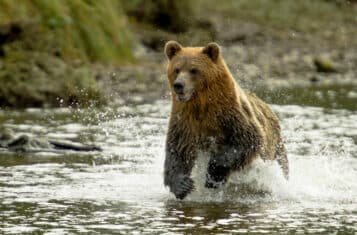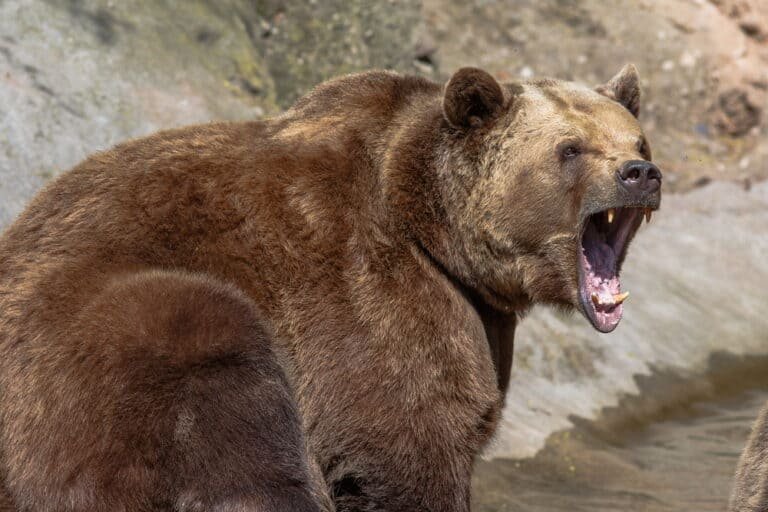Bear baiting, a historical practice stands as a compelling testament to the intricate relationship between humans and animals. Defined as the brutal sport wherein a bear is pitted against dogs, bear baiting has a long and storied past that deserves exploration. Beyond its gory spectacle lies a reflection of societal values, power dynamics, and entertainment preferences throughout different civilizations.
Definition of Bear Baiting
Bear baiting can be defined as a blood sport that involves the torment of bears by setting them against packs of dogs in an enclosed arena or pit. The primary objective is to provoke vicious confrontations between the bear and the canines, entertaining spectators who relished witnessing this display of animal aggression. Throughout history, various regions have developed their variations of bear baiting, with differences in rules, techniques, and even animals involved.
Historical Significance and Cultural Context
The cultural context surrounding bear baiting reveals insights into the values and practices prevalent during different periods. Ancient civilizations such as Rome and Greece viewed bear baiting as an extravagant display of power, strength, and dominance over nature.
The Persians and Indians also engaged in similar activities but imbued them with religious significance. However, it was in medieval Europe where bear baiting found immense popularity.
In this era marked by feudalism and chivalry codes of conduct, the sport served as entertainment for the lower classes and allowed nobles to assert their authority over beasts perceived as savage. Bear baiting became deeply ingrained within society’s fabric; it was not merely a form of amusement but also symbolized social status.
Historical Background of Bear Baiting
Origins in ancient civilizations
Bear baiting can trace its roots back to the ancient civilizations of Rome, Greece, Persia, and India. In Ancient Rome and Greece, bear baiting was a popular form of entertainment. The Romans initially introduced the concept to showcase their dominance over wild animals and display bravery.
They would organize elaborate spectacles where trained bears were pitted against warriors or other animals in grand arenas. Similarly, bear-baiting events were held in ancient Greece as part of religious festivals or public amusement.
In Persia and India, bear baiting had a slightly different cultural significance. It was often seen as a demonstration of courage and martial skill.
Warriors would engage in combat with bears to prove their courage and strength. Religious beliefs also influenced these events and were sometimes held as ceremonies to honor deities or commemorate significant occasions.
Evolution in Medieval Europe
During the Middle Ages, bear baiting evolved from its ancient origins into a wildly popular pastime throughout Europe. It became particularly prevalent during the 12th to 17th centuries.
Noble households or royal courts typically organized bear-baiting spectacles to entertain aristocracy and commoners. The Middle Ages saw an increased connection between social status and participation in bear-baiting events.
It became an activity associated with nobility and royalty; hosting such events was seen as a display of wealth, power, and cultural refinement. The nobles used these spectacles for entertainment and political purposes – strengthening alliances through lavish displays or demonstrating their dominance over vast territories.
Bear-baiting events attracted large crowds from different strata of society who relished the excitement brought by this blood sport combined with music, feasting, gambling, archery competitions, and other forms of entertainment. It became integral to medieval festivals and celebrations, serving as a community unifying force.
These historical developments highlight the evolution of bear baiting from its origins in ancient civilizations to its widespread popularity during the Middle Ages. With each passing era, bear baiting acquired new cultural dimensions and served different purposes, ultimately shaping its significance in society.
Mechanics of Bear Baiting
Selection and training of bears for baiting purposes
Bear baiting, as a form of entertainment, relied heavily on the selection and training of bears. There were two main approaches to sourcing bears: capturing wild ones or breeding captive ones specifically for this purpose. Capturing wild bears involved skilled hunters venturing into forests to ensnare or trap these majestic creatures.
The captured bears would then undergo a rigorous process of domestication and conditioning. On the other hand, breeding captive bears provided an alternative method.
Bears were raised under controlled conditions, ensuring a better understanding of their temperament and behavior from an early age. This approach allowed trainers to bond with the bears closer, making their training more effective and reducing potential risks during performances.
The baiting arena setup
To stage bear-baiting events, specially constructed bear pits or arenas were used. These enclosed spaces were designed with safety measures in mind for both the audience and participants.
Bear pits typically consisted of a circular or rectangular area surrounded by high walls or fences to contain the spectacle. The construction of these arenas varied depending on regional preferences and available resources.
Some utilized natural terrain features such as excavated earthworks or existing physical structures like amphitheaters for makeshift arenas. Others built more permanent structures using stone or wood materials with seating areas elevated around the pit to provide optimal visibility for spectators.
Safety measures were crucial because bear-baiting was inherently dangerous for all involved parties. Strong barriers between spectators and animals were erected to prevent direct contact and avoid unnecessary harm caused by unpredictable movements from either party during fights.
The Experience of Bear Baiting
Social aspects and audience participation
Bear-baiting events attracted diverse crowds from various walks of life, regardless of social status or gender. These events often served as a common ground for people of different backgrounds to unite and form a community.
The demographic makeup of attendees included nobles, commoners, and even royalty, all mingling in the shared experience. Moreover, bear-baiting played a significant role in fostering community bonding.
It allowed individuals to interact with their peers, engage in lively conversations, and strengthen social connections during the intervals between fights. The communal aspect extended beyond the event itself as it became a topic of conversation within local gatherings and taverns.
Entertainment value and spectacle
Bear-baiting events offered a wide range of spectacles to captivate audiences. These spectacles encompassed scenarios such as single bears fighting multiple dogs or multiple bears pitted against each other in fierce battles.
Additionally, bear-baiting was frequently combined with other forms of entertainment like acrobatics, music performances, comedic acts, and fireworks displays. The variety in the types of bear-baiting events ensured that each occasion was unique and unpredictable for spectators.
This added element of surprise heightened the excitement and anticipation surrounding these exhibitions. Integrating with other forms of entertainment enhanced the overall experience by catering to diverse interests and creating an immersive atmosphere that appealed to different senses.
Controversies Surrounding Bear Baiting
Ethical concerns
Bear baiting has been subject to ethical debates due to its inherent cruelty towards animals involved in these confrontations. Animal welfare issues were at the forefront as bears were physically harmed during fights against dogs or other bears.
Critics argued that confining these majestic creatures solely for human amusement went against ethical standards that prioritize respect for animal well-being. Opposition from animal rights activists further intensified concerns regarding the treatment of animals involved in bear-baiting events.
Their advocacy highlighted the unnecessary suffering inflicted upon bears and called for an end to such practices. This opposition and growing public awareness played a pivotal role in shifting public opinion and initiating change.
Legal regulations and bans
Bear baiting faced increasing opposition, leading to prohibition movements and subsequent legislative actions against the practice. These movements aimed to enact legal regulations to curtail or outright ban bear-baiting events.
The ethical concerns raised by activists gained traction among lawmakers, eventually resulting in the abolition of bear baiting in several regions. Legislative actions against bear baiting varied across different jurisdictions.
Some imposed restrictions on the methods used during fights to minimize harm inflicted on bears or dogs. Others opted for complete bans on bear-baiting events due to overwhelming consensus against the practice.
Modern-day Implications for Bear Baiting
Cultural remnants
While bear baiting is thankfully a thing of the past, its legacy can still be found in various cultural remnants today. The influence of bear baiting permeates language, idioms, literature, and even popular culture references. It serves as a reminder of the historical significance this practice held within certain societies.
In some regions where bear baiting was once prevalent, cultural festivals or reenactments are organized to commemorate this chapter of history while ensuring no harm is inflicted upon animals. These events aim to educate attendees about traditions without participating in animal cruelty.
Conservation efforts
One positive outcome resulting from the decline and eventual eradication of bear baiting is an increased focus on protecting and preserving bears as a species. Conservation efforts have gained momentum with greater awareness about animal welfare issues associated with such practices.
Today, organizations dedicated to preserving bear populations work tirelessly towards creating safe habitats for these magnificent creatures. Conservation initiatives include habitat restoration projects, research programs to understand bears’ behaviors and needs, and advocacy campaigns to raise public awareness about the importance of protecting bears and their natural environments.

Conclusion – Bear Baiting
Bear baiting, once a prominent form of entertainment, has rightfully faced opposition due to ethical concerns surrounding animal welfare. The selection and training of bears, the arena set up, and the experience it offered to audiences were all integral aspects of bear baiting’s mechanics. However, societal changes led to a perspective shift, resulting in legal regulations and bans.
Despite its controversial history, modern-day implications highlight the preservation of bears as a species and efforts to honor cultural remnants without compromising animal well-being. By learning from our past mistakes and embracing a more compassionate approach towards animals, we can create a future where humans and wildlife coexist harmoniously.







Абсолютно свежие события индустрии.
Абсолютно все эвенты известнейших подуимов.
Модные дома, бренды, высокая мода.
Свежее место для трендовых людей.
https://fashionvipclub.ru/news/2024-06-19-gruzin-kotoryy-perevernul-mirovuyu-modu-demna-gvasaliya/
Точно актуальные новости мировых подиумов.
Все мероприятия мировых подуимов.
Модные дома, лейблы, высокая мода.
Новое место для трендовых хайпбистов.
https://hypebeasts.ru/
Очень стильные события модного мира.
Абсолютно все события лучших подуимов.
Модные дома, бренды, гедонизм.
Свежее место для модных людей.
https://luxe-moda.ru/chic/162-loro-piana-lyubimyy-brend-politikov-i-biznesmenov/
Точно актуальные события подиума.
Исчерпывающие мероприятия всемирных подуимов.
Модные дома, торговые марки, haute couture.
Интересное место для трендовых хайпбистов.
https://balmain1.ru/balmain/381-kak-otlichit-originalnyy-balmain-ot-poddelki/
Very interesting subject, thanks for posting.Raise your business